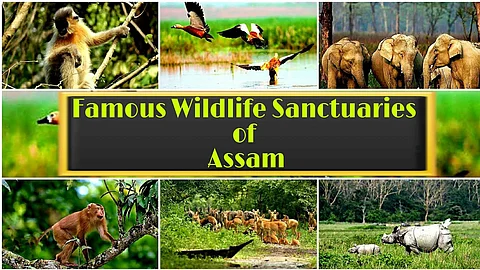
- Home
- Live Blog
- Breaking News
- Top Headlines
- Cities
- NE News
- Sentinel Media
- Sports
- Education
- Jobs

Assam is a northeastern state of India, which is renowned for its rich biodiversity and numerous wildlife sanctuaries. The wildlife sanctuaries in Assam play a crucial role in conserving the region’s unique flora and fauna. Here’s a detailed overview of the top wildlife destinations in Assam.
1. Garampani Wildlife Sanctuary
The Garampani Wildlife Sanctuary is located in the Karbi Anglong district of Assam. It is one of the oldest sanctuaries of the state as it was established in 1952. It spans an area of over 6.05 square kilometers. This sanctuary is renowned for its hot water springs and picturesque waterfalls, which add to its natural charm. It is a well-known name in wildlife tourism in Assam.
Garampani is home to a diverse range of flora and fauna. The sanctuary’s dense forests provide habitat for several species, including tigers, elephants, gaurs, hoolock gibbons, etc. It is also a haven for bird watchers, with numerous rare and migratory bird species frequenting the area. The surrounding Nambor Sanctuary, known for its 51 rare orchid species, further enhances the biodiversity of the region.
The climate in Garampani is tropical, with semi-evergreen and tropical vegetation dominating the landscape. This rich biodiversity makes Garampani a significant site for conservation and eco-tourism in Assam.
2. Laokhowa Wildlife Sanctuary
The Laokhowa Wildlife Sanctuary is located in the Nagaon district of Assam which spans an area of 70.13 square kilometers on the southern bank of the Brahmaputra River. The sanctuary was established in 1972 and forms part of the Laokhowa-Burachapori ecosystem. This sanctuary is renowned for its diverse wildlife, including the Indian Rhinoceros, Asiatic Water Buffalo, Bengal Tiger, Indian Leopard, and the Hog Deer.
Bird enthusiasts can spot over 200 species of birds, including many migratory species. The sanctuary also supports a variety of reptiles and amphibians. Despite past challenges with poaching, efforts like the Indian Rhino Vision 2020 have aimed to reintroduce and protect the Laokhowa Wildlife Sanctuary rhinos.
The Laokhowa Wildlife Sanctuary is open to tourists from November to April, offering an awesome opportunity to witness and experience Assam's rich biodiversity. The Sanctuary's proximity to Nagaon and Guwahati makes it accessible for visitors seeking to explore its natural beauty.
3. Bornadi Wildlife Sanctuary
The Bornadi Wildlife Sanctuary is located in the Udalguri and Baksa districts of Assam. It spans an area of 26.22 square kilometers. The sanctuary was established in 1980, and lies at the foothills of the Himalayas, bordering Bhutan to the North. This sanctuary is named after the Bornadi River, which flows along its western boundary.
Bornadi is particularly significant for the conservation of the Hispid Hare and the Pygmy Hog, both of which are an endangered speicies. The sanctuary also hosts a variety of other wildlife, including the Golden Langur, Clouded Leopard, and Hoolock Gibbon. Birdwatchers can enjoy the sightings of the species like the White-Capped Redstart, Blue Magpie, and various Hornbills.
The sanctuary's diverse habitats, ranging from grasslands to dense forests, support a rich biodiversity.
Visitors can explore this natural haven from November to April, which is the best time to experience the wildlife and scenic beauty. It is an important destination of wildlife tourism in Assam.
4. Pobitora Wildlife Sanctuary
The Pobitora Wildlife Sanctuary is located in the Morigaon district of Assam. It was established in 1987 and covers an area of 38.85 square kilometers. It is situated on the southern bank of the Brahmaputra River.
The sanctuary's grasslands and wetlands provide an ideal habitat for the rhinos, making it one of the best places in Assam to see these majestic creatures. Besides rhinos, Pobitora is home to a variety of other wildlife, including Wild Boars, Feral Water Buffaloes, and Golden Jackals. The hilly regions within the sanctuary also support species like the Indian Leopard and Rhesus Macaque.
Pobitora is also a birdwatcher’s paradise, and they can spot over 375 different species of birds, including various migratory birds. The sanctuary's diverse ecosystem supports a rich array of flora and fauna, making it a significant site for biodiversity conservation.
Visitors can explore Pobitora from November to April, which is the best time to visit the naturally beautiful location. It is one of the top wildlife destinations in Assam.
5. Deepor Beel Wildlife Sanctuary
The Deepor Beel Wildlife Sanctuary is located in the Kamrup district of Assam. It is a significant ecological site and the only Ramsar site in the state. It covers an area of approximately 40 square kilometers. This perennial freshwater lake is situated on the southwestern outskirts of Guwahati. It was declared a wildlife sanctuary in 1989, and is renowned for its rich biodiversity and serves as a crucial habitat for a variety of species.
The sanctuary is home to over 200 species of birds, including 70 migratory species such as the Lesser Adjutant Stork, Spot-Billed Pelican and Baer’s Pochard. It also supports a diverse range of aquatic life, including 50 species of fish and numerous reptiles and amphibians. The lake's wetlands are vital for the survival of many local communities, providing resources like fish and medicinal plants.
Deepor Beel faces several environmental challenges, including pollution from urban wastes, encroachment and habitat disruption due to railway construction. Despite these issues, it remains a popular destination for birdwatchers and nature enthusiasts, especially during the winter months when migratory birds flock to the area.
In conclusion, the wildlife sanctuaries in Assam are playing a very vital and important role with the conservation of various endangered species. Among the most famous wildlife sanctuaries in India, they provide a safe zone for species to live their life peacefully and co-exist alongside humans. Without them, the world would have lost many valuable species and it would have affected the nature's balance. So, we must help protect these sanctuaries by respecting its cleanliness and not polluting it with toxic chemicals or plastic bags.
ALSO WATCH: